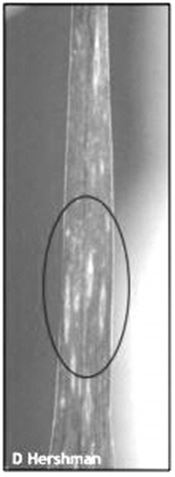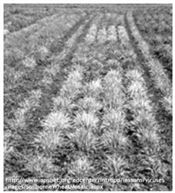Cool Season Viruses In Wheat
DR. NATHAN KLECZEWSKI
URBANA, ILL.
Currently, most small grains are approaching jointing or just past jointing in many parts of the state. Now is the time that you most likely will start to see early season viral diseases in some fields, specifically Wheat Soilborne Mosaic Virus and Wheat Spindle Streak Virus. These diseases are transmitted by soil borne microbes that thrive in cool, wet conditions. Infected plants typically are chlorotic and may be stunted. Often affected plants occur in low lying areas of the field or areas suffering from compaction. However, on some occasions entire fields can become symptomatic. Symptoms of spindle streak include necrotic dashes that run along the venation, giving the appearance of a spindle (Figure 1). Additional symptoms of soilborne mosaic virus are less conspicuous, but include mottling of lower foliage (Figure 2). Symptoms, including chlorosis and even stunting can look very similar to nutirent deficiencies. Symptoms cease once temperatures are above 65°F and may be reduced after fertilization. Even though symptoms may be reduced, it does not mean the viruses and their effects are removed from the crop. I consider these diseases hidden yield robbers due to the fact that they often go misdiagnosed as nutrient issues and their effects often go unnoticed. Confirmation can only be made through specialized testing methods such as ELISA and PCR. The University of Illinois Clinic and Agdia are two options for having samples tested.
How should you send a virus sample? The key for getting good virus results is to keep the sample cool and avoid excess moisture. If the samples get warm or are kept too wet microbes can degrade the viruses, resulting in false negative results. Place 15-20 leaves in a plastic bag with a dry paper towel and place immediately in a cooler on ice. Make sure to ship samples overnight on ice early in the week so that they are processed immediately and not allowed to set at room temperature. Our lab is conducting a wheat virus survey in 2019 and we are seeking people to help us sample fields. If you are interested in helping, send me an email .
What should you keep in mind? 1) Keep track of fields with these viruses. Once the viruses are established they will be present in those fields from here on out. 2) Try to harvest or work in these fields last to prevent spread to other fields. 3) Avoid compaction. 4) Plant tolerant varieties in fields with a history of these viruses. Unfortunately many varieties are screened for these viruses as a complex, so it may be difficult to determine if you are planting a spindle streak or soilborne mosaic tolerant variety in these cases. However, the University of Illinois is one of the few places that does conduct screening for these viruses. ∆
DR. NATHAN KLECZEWSKI: Extension Plant Pathologist, University of Illinois

Figure 1. Symptoms of wheat spindle streak virus in wheat.

Figure 2. Symptoms of wheat soilborne mosiac virus.